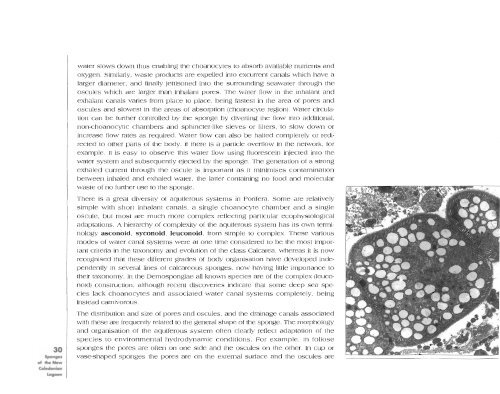Sponges of the New Caledonian lagoon - IRD
Sponges of the New Caledonian lagoon - IRD
Sponges of the New Caledonian lagoon - IRD
Create successful ePaper yourself
Turn your PDF publications into a flip-book with our unique Google optimized e-Paper software.
30<br />
<strong>Sponges</strong><br />
<strong>of</strong> <strong>the</strong> <strong>New</strong><br />
<strong>Caledonian</strong><br />
Lagoon<br />
water slows down thus enabling <strong>the</strong> choanocytes to absorb available nutrients and<br />
oxygen. Similarly, waste products are expelled into excurrent canals which have a<br />
larger diameter, and finally jettisoned into <strong>the</strong> surrounding seawater through <strong>the</strong><br />
oscules which are larger than inhalant pores. The water flow in <strong>the</strong> inhalant and<br />
exhalant canals varies from place to place, being fastest in <strong>the</strong> area <strong>of</strong> pores and<br />
oscules and slowest in <strong>the</strong> areas <strong>of</strong> absorption (choanocyte region). Water circula<br />
tion can be fur<strong>the</strong>r controlled by <strong>the</strong> sponge by diverting <strong>the</strong> flow into additional,<br />
non-choanocytic chambers and sphincter-like sieves or filters, to slow down or<br />
increase flow rates as required. Water flow can also be halted completely or redirected<br />
to o<strong>the</strong>r parts <strong>of</strong> <strong>the</strong> body, if <strong>the</strong>re is a particle overflow in <strong>the</strong> network, for<br />
example. It is easy to observe this water flow using fluorescein injected into <strong>the</strong><br />
water system and subsequently ejected by <strong>the</strong> sponge. The generation <strong>of</strong> a strong<br />
exhaled current through <strong>the</strong> oscule is important as it minimises contamination<br />
between inhaled and exhaled water, <strong>the</strong> latter containing no food and molecular<br />
waste <strong>of</strong> no fur<strong>the</strong>r use to <strong>the</strong> sponge.<br />
There is a great diversity <strong>of</strong> aquiferous systems in Porifera. Some are relatively<br />
simple with short inhalant canals, a single choanocyte chamber and a single<br />
oscule, but most are much more complex reflecting particular ecophysiological<br />
adaptations. A hierarchy <strong>of</strong> complexity <strong>of</strong> <strong>the</strong> aquiferous system has its own terminology<br />
asconoid, syconoid, leuconoid, from simple to complex. These various<br />
modes <strong>of</strong> water canal systems were at one time considered to be <strong>the</strong> most important<br />
criteria in <strong>the</strong> taxonomy and evolution <strong>of</strong> <strong>the</strong> class Calcarea, whereas it is now<br />
recognised that <strong>the</strong>se different grades <strong>of</strong> body organisation have developed independently<br />
in several lines <strong>of</strong> calcareous sponges, now haVing little importance to<br />
<strong>the</strong>ir taxonomy. In <strong>the</strong> oemospongiae all known species are <strong>of</strong> <strong>the</strong> complex (Ieuconoid)<br />
construction, although recent discoveries indicate that some deep sea species<br />
lack choanocytes and associated water canal systems completely, being<br />
instead carnivorous.<br />
The distribution and size <strong>of</strong> pores and oscules, and <strong>the</strong> drainage canals associated<br />
with <strong>the</strong>se are frequently related to <strong>the</strong> general shape <strong>of</strong> <strong>the</strong> sponge. The morphology<br />
and organisation <strong>of</strong> <strong>the</strong> aquiferous system <strong>of</strong>ten clearly reflect adaptation <strong>of</strong> <strong>the</strong><br />
species to environmental hydrodynamic conditions. For example, in foliose<br />
sponges <strong>the</strong> pores are <strong>of</strong>ten on one side and <strong>the</strong> oscules on <strong>the</strong> o<strong>the</strong>r. In cup or<br />
vase-shaped sponges <strong>the</strong> pores are on <strong>the</strong> external surface and <strong>the</strong> oscules are

















